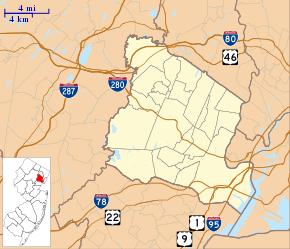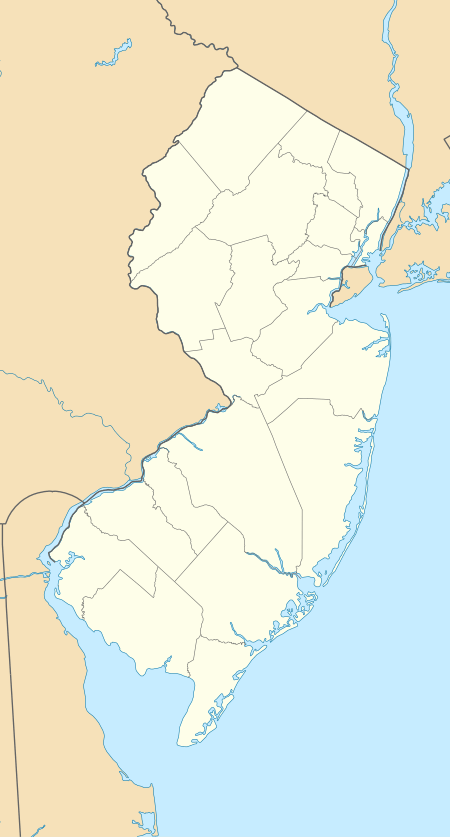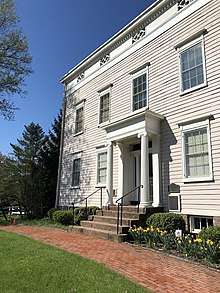Crane House and Museum
The Israel Crane House is a federal-style home located at 110 Orange Road in Montclair, Essex County, New Jersey, United States. The house has had a rich history and is listed on several State registries and the Federal historic registry.
Crane House and Historic YWCA | |
   | |
| Location | 110 Orange Road Montclair, New Jersey |
|---|---|
| Coordinates | 40.81155°N 74.22299°W |
| Area | 1.1 acres (0.45 ha) |
| Built | 1796 |
| Architect | Unknown |
| NRHP reference No. | 73001091[1] |
| NJRHP No. | 1118[2] |
| Significant dates | |
| Added to NRHP | March 14, 1973 |
| Designated NJRHP | August 7, 1972 |
History and ownership of the Crane House and Historic YWCA (1796 to date)
The Crane House was built by Israel Crane in 1796 on Old Road (now Glen Ridge Avenue) in Cranetown, which is now the southern part of the Township of Montclair.[3] The house stayed in the Crane family until 1920, when it was purchased by the YWCA.[4] The YWCA used the house for offices, dormitories and as a social center for African American women and girls for 45 years. In 1965, the house faced the prospect of demolition. Local residents committed to its preservation organized and the house was moved from Old Road to 110 Orange Road, its current address. The Crane House and Historic YWCA is one of the few remaining federal mansions in northern New Jersey. It currently operates as the Crane House and Historic YWCA, which is open to the public for tours. The Crane House and Historic YWCA neighbors two other buildings with historic significance: the Clark House, which houses the Albert Payson Terhune library, and the Nathaniel Crane House, which houses a General Store collection, schoolroom, and gift shop. These buildings are also owned by the Montclair Historical Society.
Israel Crane and his commitment to commerce
Israel Crane (b. 1774) was a direct descendant of the Crane family, which founded Cranetown in 1694. He was an enterprising businessman, successful in several industries including cider, cotton and wool production.[4] In 1801, he and a partner leased a site in Paterson, New Jersey, for one of the first mills to use the power of the Passaic River. In 1806, Crane organized a group to build the Newark-Pompton Turnpike, an industrial toll road of which he later became the sole owner. It was a direct route from Newark, New Jersey to outlying areas, including Cranetown.[4] Today, Bloomfield Avenue, which runs West from Newark through the Township of Montclair into Verona, New Jersey, is part of the original Newark-Pompton Turnpike.[4] Another section has evolved into Route 23, which extends to Port Jervis.
Historical listings
- Historic American Buildings Survey (1935)
- New Jersey Historic Sites Evaluation (1961)
- New Jersey Register of Historic Places (1972)
- National Register of Historic Places (1973)[1]
Visiting the Crane House and Historic YWCA
The Crane House and Museum is open to the public for guided tours Wednesdays (except in August) from 1:00 pm – 3:00 pm. School groups can visit the Crane House and Museum weekdays (with advance reservations) and can make use of the exhibition center and meeting space.
Exhibits at the Crane House and Historic YWCA
The Crane House has ten rooms, each containing 18th and 19th century furniture, paintings and decorative arts, including rugs, quilts, ceramics, glassware, silverware, toys, dolls and household items. Special items on display include a painted bedroom set owned by Paul Revere IV (1816), a harp made by Sebastian Erard (1827), and a William and Mary highboy (1740).[4]
See also
References

- "National Register Information System". National Register of Historic Places. National Park Service. July 9, 2010.
- "New Jersey and National Registers of Historic Places - Essex County" (PDF). New Jersey Department of Environmental Protection - Historic Preservation Office. August 22, 2016. p. 7.
- www.montclairlibrary.org Archived 2010-05-25 at the Wayback Machine
- Our Collection - Crane House Museum Archived 2008-05-18 at the Wayback Machine. Montclair Historical Society. Retrieved on 2008-03-25
- Our Collection - Crane House Museum. Montclair Historical Society. Retrieved on 2008-03-25.
External links
- Official website
- Historic American Buildings Survey (HABS) No. HABS NJ-152, "King Crane House, 159 Glenridge Avenue, Montclair, Essex County, NJ", 4 photos, 16 measured drawings, 3 data pages, supplemental material
